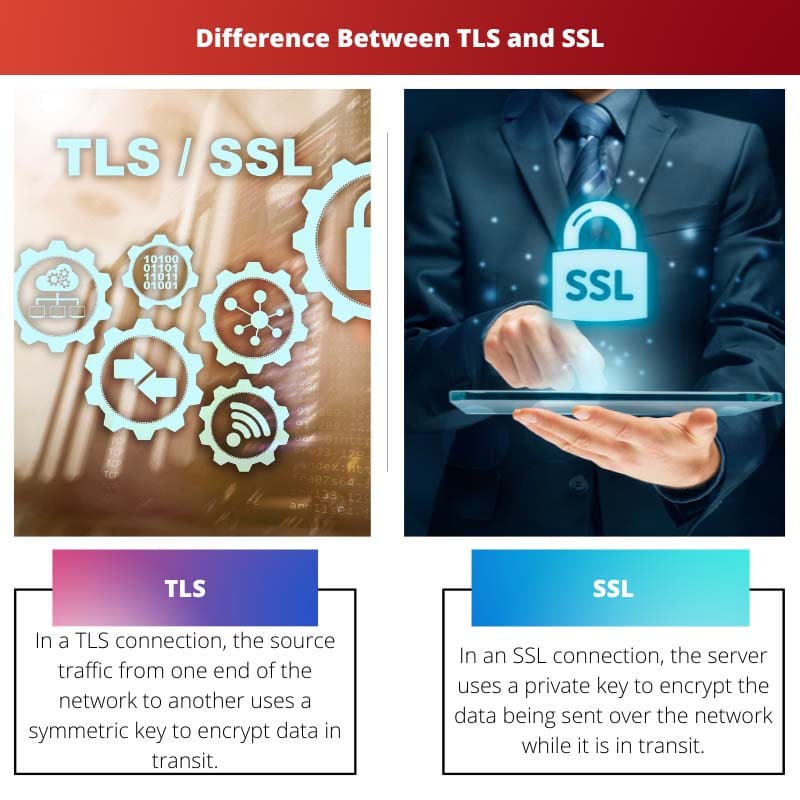Day-to-day, more and more people are perceiving the worthiness of keeping their individual information private. As a result, TLS and SSL have become a crucial part of the influential security schemes.
Both TLS and SSL are exceptionally similar, yet they are extraordinarily different too.
Key Takeaways
- TLS (Transport Layer Security) is the successor to SSL (Secure Sockets Layer) and provides stronger security features.
- TLS supports a wider range of cryptographic algorithms than SSL, offering more flexibility in encryption.
- TLS has better performance and speed due to improved handshake protocols, making it the preferred choice for modern web applications.
TLS vs SSL
Transport Layer Security (TLS) and Secure Sockets Layer (SSL) are cryptographic protocols used for securing communications over a network. TLS is the newer and more secure version, with several improvements over SSL, which is now largely deprecated due to known vulnerabilities.

In a TLS connection, the source traffic from one end of the network to another uses a symmetric key to encrypt data in transit. This process is referred to as an asymmetric or public-key encryption algorithm that can use either RSA or DSA (a modified version of RSA) algorithms.
In an SSL connection, the server uses a private key to encrypt the data being sent over the network while it is in transit. The session is encrypted with a symmetric key using a cipher.
The data itself is decrypted by the webserver upon receipt at the destination.
Comparison Table
| Parameters of Comparison | TLS | SSL |
|---|---|---|
| Elision | Transport Layer Security. | Secure Socket Layer |
| Defense Guard | It has a high defense guard. | It has a slightly low defense guard. |
| Interest | The benefit of TLS is that once the connection between the client and server has been secured by TLS, sensitive information can be sent over the network safely. | Secure Socket Layer protects the credentials against data theft by encrypting all of your private information |
| Transfer Category | Data transferred via TLS is encrypted by either asymmetric (public key) encryption or symmetric (private key) encryption. | SSL has been the industry standard for encrypted web transactions. |
| Illustration | To do banking or make credit card payments online. | Provides a way for users to send sensitive information, like passwords and social security numbers. |
What is TLS?
The Transport Layer Security (TLS) protocol is what makes transactions between browsers and servers safe for online shopping, banking, or any other activity that requires the protection of credit card information. TLS relies on two important pieces public-key cryptography and a handshake process to produce a secure channel.
Public key cryptography is a more or less known system where the sender of the data encrypts it with another party’s public key before sending it on to the receiver, who decrypts it with her private key. This means that the two keys are paired, and only one of them can be used to decrypt the data.
The basic idea is to use a public key, which anyone can read and even send random messages encrypted with it, so it is not known for sure who owns this key.
To begin a TLS session, the browser creates a random symmetric key, encrypts it with the public key provided by a server, and sends it on. Once the server receives it, it decrypts this message using its private key, then re-encrypts it with the same symmetric key and sends it back.
The browser does the same and compares the two results. If they’re the same, it means that no one has tampered with the data.
Otherwise, someone may have meddled with it (for example, by changing a message to include a private key).
What is SSL?
SSL encrypts sensitive data, such as credit card information, before it’s transferred over a network. This technology is used by many web browsers to show a padlock icon in their address bar and verify that the site the user is visiting is using an encrypted connection.
Moreover, it ensures the authenticity of a server and the message delivered from it.
SSL implementations are vulnerable to attack. It is strongly recommended to disable automatic renewal of SSL sessions on Web servers.
The reason to ask your website administrator to disable the default setting is so that you don’t have misleading information in your certificate. This can cause a denial-of-service attack.
Malicious attackers will not be able to view the secure site; however, they will be able to see the “missing” padlock icon on cytoplasmic browsers.
SSL is a cryptographic procedure utilized for securing the confidentiality of data on computer networks. Moreover, it will try to brute force the information from the server.
However, that is just a squander of time. The attacker will not get anything from the server and might get their IP address banned.
SSL encryption uses three primary layers a transport layer, an application layer, and an endpoint layer, where it is an encrypted email protocol used to encrypt data sent across the Internet. It uses the Advanced Encryption Standard algorithm.

Main Differences Between TLS and SSL
- The TLS elision is Transport Layer Security, whereas the SSL elision is Secure Socket Layer.
- TLS has a high invulnerability guard, whereas SSL has a slightly low invulnerability guard.
- TLS interest is any sensitive facts that can be transferred over the network shielded, whereas SSL interest includes defense of the credentials against data stealing.
- The TLS transfer category is encrypted by either public-key encryption or private key encryption, whereas the SSL transfer category is the industry standard.
- The illustration of TLS is banking and online transactions, whereas SSL illustration includes shielding of passwords and social security numbers.

References
- https://books.google.com/books?hl=en&lr=&id=jm6uDgAAQBAJ&oi=fnd&pg=PR7&dq=TLS+and+SSL&ots=XKOsnZorWE&sig=_Aisvp5r8eBEghXiAhCTLZL19kE
- https://link.springer.com/chapter/10.1007/978-3-540-45146-4_34